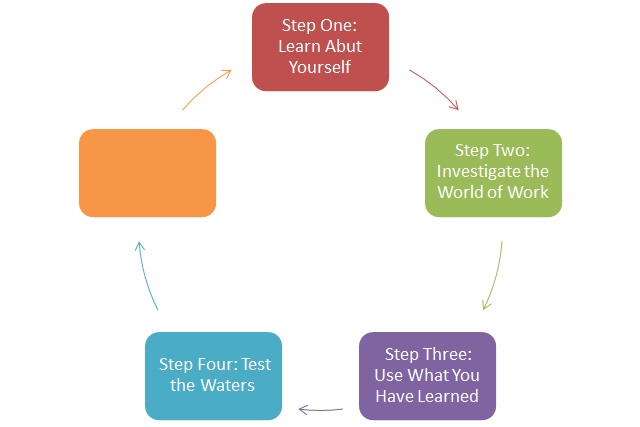Step Four: Test the Waters

Step One: Learn About Yourself
Step Two: Investigate the World of Work
Step Three: Use What You Have Learned
Step Four: Test the Waters
Step Four: Test the Waters CCPG_87-102 ![]()
Non-traditional Work – Approximately 33% of the American workforce is “non-traditional,” meaning they work part-time, have temporary jobs are self-employed, or work in a field that historically has not employed their gender and/or ethnic group. Volunteering is also non-traditional work. You don’t get paid but you gain other benefits, such as experience and contacts. While non-traditional work is a way of life for some, for others it’s a temporary measure and a great job-hunting tool.
Temp Work – “Temping” means that you work in a position temporarily—from one day to one year. You actually are employed by an agency that sends you to other companies to work. These days, some companies only hire employees who begin as temp workers.
Volunteering – Like temping, volunteering is a way to try out a job or type of work before you commit yourself to it “permanently.” It also provides a way to make connections outside the employment arena. To maximize the benefits, devote at least 100 hours to each volunteer position to show that you are committed.
Free Agency/Self-Employment – Free agents are temp workers who skip the “middle man.” Instead of going through a temp agency, you approach a company directly and offer to work on a temporary basis.
Resume Considerations – Describing your temping, volunteering and free agency work on your resume when you try to find full-time “permanent” employment can present some challenges.
Entrepreneurial Work – Having the responsibility of designing, developing, and overseeing the daily activities of your own business can be exciting, challenging, and a completely satisfying work environment for many people. If you are thinking of starting your own business, you may want to review the following statements.
Green Careers – vents in the past decade, both socially and politically, have reinvigorated a movement that first came into the public eye in the early 1960’s. The Green Movement has brought attention to the need to implement and incorporate values into the workplace that aim to reduce the impact our lifestyles have on the environment. At the same time, this movement has brought about an increase in the creation and availability of Green Careers, or jobs that focus on reducing the cumulative and harmful effects on the environment through various actions including: conservation, invention, public awareness, and research.
The U.S. Military – How about getting an education from Uncle Sam? Did you know that the US military offers job training, continuing education, financial aid, and a host of other benefits to qualifying candidates? No? Better take another look at what the various branches offer.
Apprenticeships – A State of California-approved apprenticeship program is an “earn and learn” work-based education program. They range in length from one to five years depending on the complexity of the knowledge and skills to be learned.
Problem Work History – When you communicate with employers, the key words are: honesty, openness and employer-focus (not self-focus). Never put anything negative in your resume and/or application form but don’t lie, either. The application, for example, is a legal contract. However, you can put a positive spin on your past and any problems in your work history.
Step Four: Summary Worksheet CCPG_103-104 ![]()